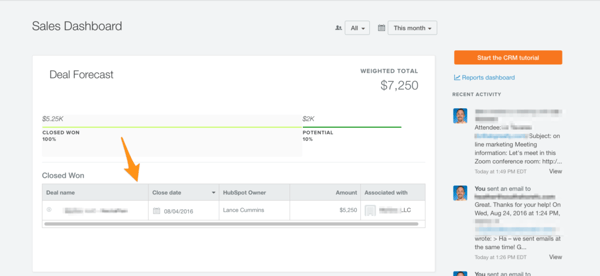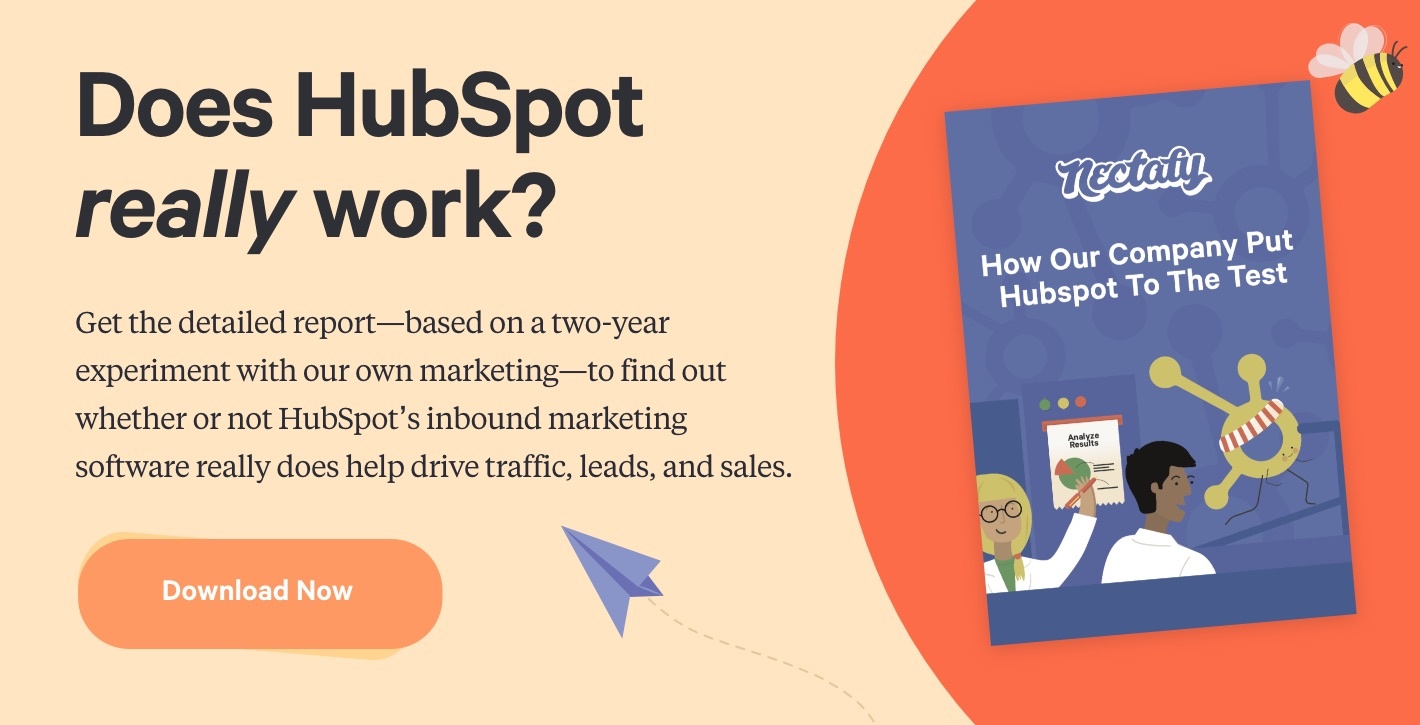An Extensive HubSpot CRM Review: What You Want (& Need) To Know


 Disclosure: We only review products we use here at Nectafy. Some of the links in this article are affiliate links that may provide Nectafy with a small commission at no cost to you.
Disclosure: We only review products we use here at Nectafy. Some of the links in this article are affiliate links that may provide Nectafy with a small commission at no cost to you.
Is HubSpot’s customer relationship management (CRM) tool the right choice for your sales team?
I honestly can’t tell you that. But I’m confident that by the end of this article, you’ll be more informed than you imagined you could be—without spending ridiculous amounts of time solving the CRM riddle. (Although reading 6,000 words may take a moderately ridiculous amount of time. Feel free to skip to the juicy parts.)
For starters, I don’t know the exact reason you’re in the market for a CRM. Maybe your sales team uses your existing CRM like experts, and you’re looking to add a specific feature, like auto-dial or win/lose callback data, that’ll launch your team’s productivity into the stratosphere. Or maybe your top salesperson is starting to lose her Post-it notes or your “closer” accidentally deleted the Excel spreadsheet that he has meticulously updated over the last eight years, and it’s time to get everyone onto the same system with one set of data.
In any case, there is a pretty broad spectrum of needs.
So I don’t know if HubSpot CRM is right for you. What I can do is tell you about our needs and our experience with HubSpot CRM over the last 12 months. As you may know from some of my other posts, I tend to take the plunge and just try things, then share how it all went.
By the end of this post, you’ll know just about everything I know about HubSpot CRM, warts and all.
First, you should know that I’ve tried a few other CRMs over the last five years. I’m a “fiddler” at times, and that means I’ve burned through more than a few software-as-a-service (SaaS) options. But they haven’t all been bad experiences. In fact, I would say that most of those CRMs were exactly what I needed at the time.
Let me ‘splain.
Related: How Our Company Put HubSpot's Marketing Software To The Test
To All The CRMs I’ve Used Before
Capsule CRM
When I first started my company, I desperately wanted a CRM that had exactly what I needed and no more. I didn’t want automation. I didn’t want sales templates. I didn’t want tons of data points. At that stage in my sales process development, those features just got in the way. Instead I wanted:
- A way to keep prospect and client information all in one place.
- A simple way to see what opportunities I was working on.
- A clear vision of what I needed to do next to move those opportunities forward.
I instantly fell in love with Capsule CRM.
There’s a free version of the CRM, but it’s limited in the number of contacts you can add, so I willingly upgraded to the paid version. At $12 per user, that’s a no-brainer.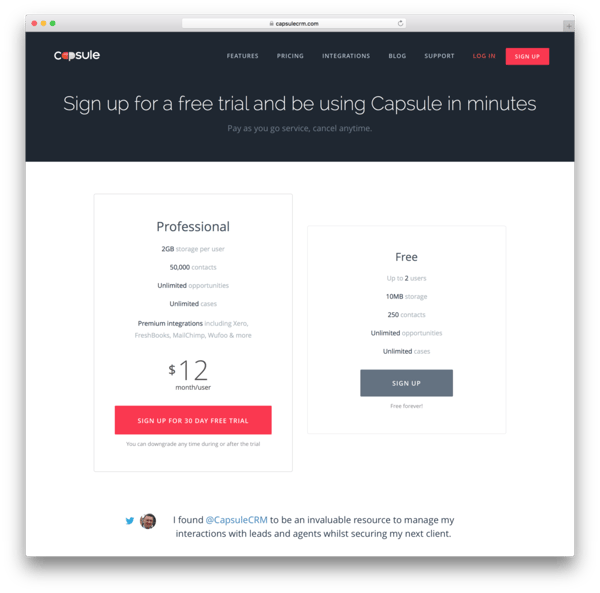 At the time, Capsule CRM was perfect for my needs. But one day (several years ago, now) I remember thinking, “Man, I wish I could use my Google Apps email and bring all of this goodness together.” And so, I began a search for the next step in my CRM growth. (By the way, while writing this article, I went back to take a look at the latest version of Capsule. It’s looking really beautiful and has a ton of new integrations. They’re making it hard not to want to come back.)
At the time, Capsule CRM was perfect for my needs. But one day (several years ago, now) I remember thinking, “Man, I wish I could use my Google Apps email and bring all of this goodness together.” And so, I began a search for the next step in my CRM growth. (By the way, while writing this article, I went back to take a look at the latest version of Capsule. It’s looking really beautiful and has a ton of new integrations. They’re making it hard not to want to come back.)
If you’re just getting started with a CRM, and what you really want is a very powerful way to get all of your contacts—customers, prospects, or supporters—in one place, I’d recommend Capsule in a heartbeat.
Base CRM
Capsule spoiled me with its beautiful, simple interface. So when I went looking for a CRM that integrated with Gmail, I was impressed by the sleek design of Base CRM. In the years since, the Base team has amped up what the CRM can do. Now it’s a fully featured CRM targeted at salespeople who want everything in one place.
Base CRM did a fantastic job linking my prospects’ emails to their records, and it also had some pretty impressive reporting tools, which would have been a huge plus if I had a larger sales team. (In retrospect it’s kind of weird to run reports on your own activity to see how you’re doing… but I digress.)
Often a platform that does everything has a difficult time nailing any one thing, but that’s not the case here. I think Base CRM is well-designed and delivers a lot of value. But the price tag can be a little off-putting. About the time I was using it, Henry joined the team, and I wanted to add him to the CRM.
What I got was a serious jolt.
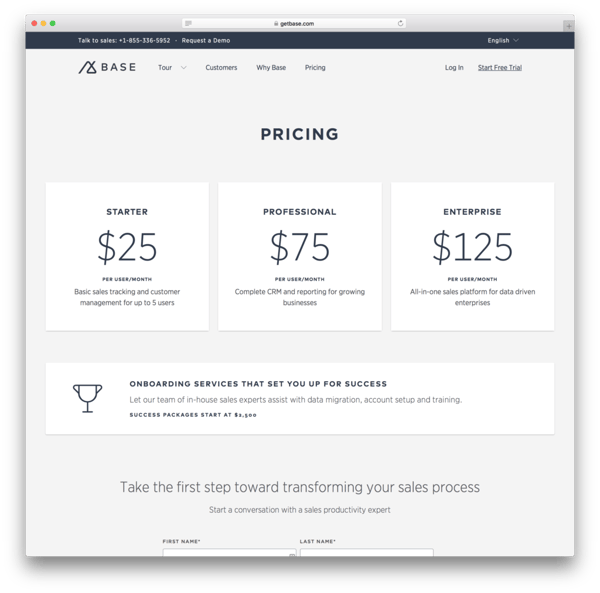 I had just graduated from paying $12 per month to paying $75 per month, times two! Whoa. At the time, I hadn’t yet realized the full value of Base CRM, so I set out on a hunt once again to find a platform that did not do everything, but did what I needed and did it well.
I had just graduated from paying $12 per month to paying $75 per month, times two! Whoa. At the time, I hadn’t yet realized the full value of Base CRM, so I set out on a hunt once again to find a platform that did not do everything, but did what I needed and did it well.
Magically, I found Pipedrive. (Well, I don’t know if it was magic or not, but I loved the visual layout of Pipedrive—it was super easy for this right-brainer to understand.)
Pipedrive CRM
Pipedrive is very simple to use—it has a drag-and-drop interface that made it easy to know what needed to happen next in our sales process. It interacted well with our Gmail (we use Google Apps to power just about everything), it clearly showed who had been assigned certain tasks, and it was inexpensive—it ended up costing about $9 per user (which is ridiculously cheap compared to a lot of the competition).
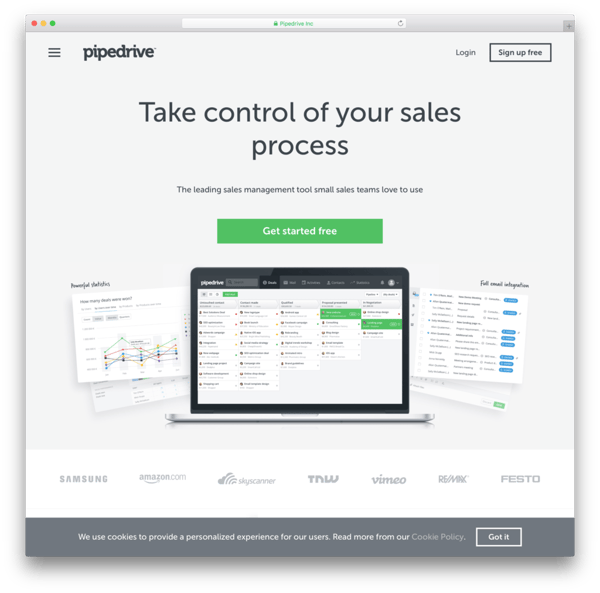
About that time, we also started using HubSpot as our marketing automation platform. So, we quickly fired up the integration with Zapier, which allowed us to connect Pipedrive to HubSpot. When someone became a marketing qualified lead in HubSpot, that contact would automatically be created in Pipedrive as a new deal. Perfect.
The number-one coolest feature for Pipedrive, hands down, is this: There is a visual indicator on every deal in your pipeline that shows you the status of your next task. It’s quick to assign a task to a deal, and as long as you keep your deals “green,” you’re staying in touch with everyone in your pipeline. Simple and brilliant.
Compared to Capsule and Base, the interface looked a bit dated, but I could forgive that. The functionality was right on.
Also, it had strong, clear reporting on pipeline activity that proved to be very helpful.
So, if we loved Pipedrive so much, why the sudden need to run to HubSpot CRM?
Why We Switched To HubSpot CRM
We decided to give HubSpot’s CRM a try because we wanted to see how well it would integrate with the other HubSpot tools we use. We have become 100% fueled by inbound marketing, and we’ve been thoroughly convinced that HubSpot actually works for us. We have seen the value of removing the divide between marketing and sales. We want to get the maximum value from our early research on leads so that when we’re in the sales process, we have all the key information about their involvement with our website.
While we felt that Pipedrive integrated well with HubSpot, we figured the integration would have to be even better with HubSpot’s CRM, since it would all be on the same platform.
In particular, we knew HubSpot CRM would allow us to see a contact’s timeline, including what emails they’ve opened, which seemed like a more effective way to track what was happening in the funnel.
So, after years of using other light-to-medium CRM solutions, we took the plunge into HubSpot.
Note: Back in December 2015, after three months of using HubSpot CRM, we shared some of our initial observations. I’ve decided to leave them intact so you could see the progression of what I’ve learned and what has and hasn’t changed, though there are a few updates included. When I started this huge review, little did I know that HubSpot would alter much of their interface just after Inbound 2016, so there will definitely be an update to this update before too long. Stay tuned.
HubSpot CRM Review: After 3 Months
What We Like
After using HubSpot’s CRM for three months, here’s what we like about it:
- It’s integrated with Sidekick (now HubSpot Sales), which we already used. Sidekick is a HubSpot app for email with several really great features. One of our favorites is that it notifies you when emails you send have been opened. Another is the information it provides when you receive an email—Sidekick displays that person’s contact information on the right side of your screen, and when you click it, it takes you to the HubSpot CRM where you can view the person in your sales funnel. From there, you can send emails and see complete tracking information.
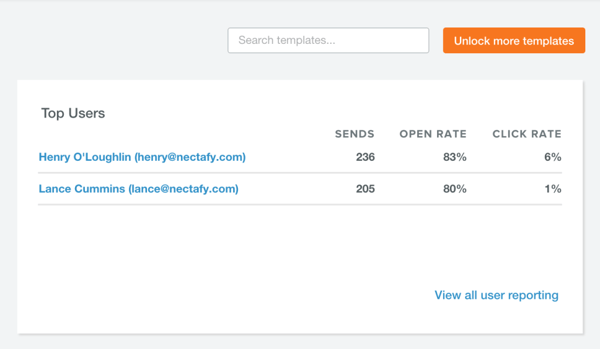
- The CRM has a high quality mobile app. The app makes it really easy to get the data you need about your sales process. We’re not on the road much, but when we are, the app is helpful.
- You can drag deals from one stage to the next, and set follow-up tasks for them so none of your contacts slip through the cracks.
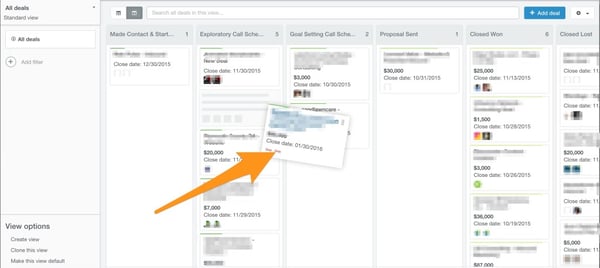
- All emails are logged from Google Apps into the individual’s record in the CRM.
- The CRM is free. (Although to unlock the potential of more than five templates, you have to pay $50 per user, which seems like a pretty steep jump. That part would probably go on our “don’t like” list.)
What We Don’t Like
- It’s not as integrated as we expected. In fact, we felt like it was a little clunky to work with in terms of deals.
- If we’re working on the marketing side of HubSpot and we pull up a contact record, there’s no button or link that takes you over to the sales side of that contact. (Update: HubSpot has updated the interface so you see the same data, and have almost the same functionality.)
- If you lose a deal, you’re constantly reminded of it. When you lose a deal, you move it over to a column of lost deals, and that list stays on your screen instead of disappearing—so you’re constantly reminded of all the opportunities you lost. (I don’t know about you, but we don’t enjoy being reminded of our failures on a daily basis—we’d at least like the option of hiding the list!) (Update: Thanks to a reader, we have figured out how to filter this column. It’s still there, but it’s blank.)

- There is lag time. If we send someone an email, it sometimes takes a while to show up on our list as “contacted.” (Update: It appears that HubSpot has improved the functionality of its database. Now the lag is just a couple of seconds.)
- There’s no good way to keep track of who you’ve contacted or what the next step is. For example, if I want to make sure I’m keeping in touch with someone on my list of contacts, the only way for me to do that is to manually go in and create a new deal, and then set up tasks. (We like that you can set up tasks, but the extra steps it requires makes it less than ideal.)
- It’s almost too complex for our needs. There are tons of filters you can use, which is cool, but not necessarily something we want or need. (Keep in mind that we have a sales team of two people—Lance and Henry—so we aren’t running the most complex sales process around.)
What Did We Think After 3 Months Of Use?
Overall (as of December 2015), HubSpot’s CRM seems to be slightly immature in its development. We probably just need to spend more time with the platform, but right now we feel like there are still some pieces of it that need a little work, especially for the early part of the sales process.
For example, the CRM’s system of dragging and dropping cards from one column to the next is only part of the “deals” portion of the platform—not the “contacts” side. So, if you want to keep track of a contact who is not yet ready to be considered a deal, you can’t—at least not with the drag-and-drop feature.
Really, the only way you can keep track of a contact is if you create a deal. The problem there is that you only want to create deals when you feel confident about that person moving forward in your sales process (which is hard to know if you’ve only just contacted them for the first time).
We do like that the information we gather about a lead and their activity is integrated with their sales profile and that there’s a lot of functionality around being able to build views so you can customize lists based on specific criteria from a prospects’ activity or status. We also really enjoy the Sidekick plugin and its ability to give us information about a contact and their social channels.
As a frequent user, here’s what Henry had to say:
“On the whole, I prefer working in Pipedrive to manage the sales process. But we do get better data with the HubSpot CRM and it integrates better with our marketing platform (also HubSpot). We’ve decided to stick with it for those reasons, but we’re hoping to see improvements.”
In all, HubSpot’s CRM just didn’t give us the boost in integration we were hoping for. What we would love to see is more documentation from HubSpot on the best ways to use this platform, so we can learn more about it.
Now after spending another nine months with HubSpot CRM, I’m ready to dive in even deeper to show you what I think.
HubSpot CRM Review After One Year
My Full HubSpot CRM Analysis, Piece By Piece
Dashboard
Deal Forecast
I like its simplicity. It’s laid out backward from the order of my deal stages, which is confusing at first. (But, hey, I studied Hebrew in a past life, so I should be able to think right-to-left every now and then.) And I don’t do a great job of updating close dates, or I think I may actually get something more useful here.
Productivity
This section is simple and to-the-point.
- Calls Placed—We don’t usually call leads within the CRM. Most of our initial follow-up is via email, and then we do a ton of web video meetings because they are so effective at building rapport. (Huge hat tip to Zoom here.) The idea of a call queue makes me feel a bit like vomiting in my mouth, but I know there are wonderful uses for this kind of technology. Maybe your company only uses its power for good.
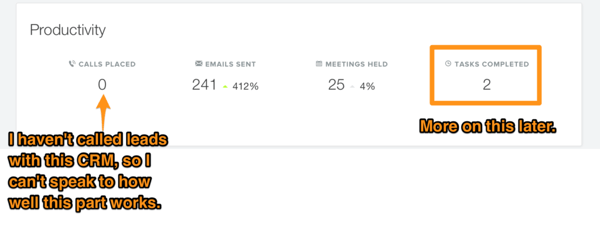
- Emails Sent—This can be a bit deceptive because of the auto log feature from my Gmail. Because I never remember to uncheck my “Log in CRM” box, every single person I email gets logged as a lead and a sales email. Then, daily, I go in and delete leads from the CRM that shouldn’t be there. (More on this in my “What I Wish It Could Do” section later.)
- Meetings Held—By using the Google Calendar integration, any meeting that I schedule with a contact in my HubSpot CRM gets pulled into this report. This is amazing and wonderful. It actually makes me tear up a little. All kidding aside, I rely very heavily on Google Calendar for keeping my life on track, so this feature is huge. I especially like that HubSpot doesn’t force me to use its meeting scheduler, because I already have a preferred meeting scheduler software that works well for me. More on that in a bit.
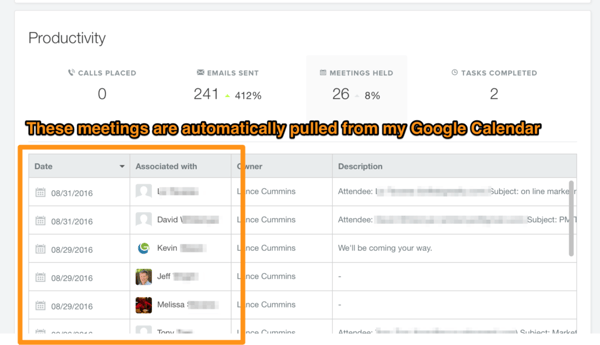
- Tasks Completed—I’ll confess that I’m not exactly nailing this one. When you add a task to a contact or a deal, HubSpot appends it to your Google Calendar; when you complete it, you get the news here.
Pipeline

This shows a nice funnel of what’s happening with your pipeline at a very high level.
- Assigned—Just as a side note, I ran a giant workflow update using HubSpot’s marketing tool to assign previously unassigned contacts to me. Makes for a fun number.
- Contacted—Counts the number of contacts you’ve emailed from your email software or the CRM. If you’re using the HubSpot marketing tool, it excludes any kind of contact that the lead is getting from that side of the application. I’m not sure if that’s a good thing or not… more on that later.
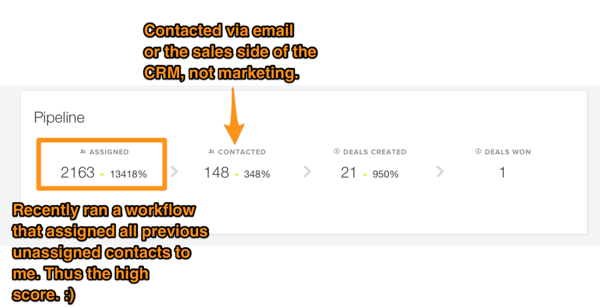
- Deals Created—I create deals in one of two ways. Either I manually add a deal, which is very simple to do (I’ll show you in a bit.), or I create a workflow on the HubSpot marketing side that automatically creates a new deal in the sales tool if a lead reaches a lead score of 50. This is a great example of the power of having our marketing and sales tool on an (almost) unified platform.
- Deals Won—My favorite category. The cool part of how HubSpot CRM treats a “win” is that it marks the contact’s Lifecycle Stage as Customer. Then you’ll be able to report on the marketing side to show actual ROI on your marketing efforts.
That’s all there is. There isn’t any more.
This is probably one of the biggest disappointments of HubSpot CRM for me. Apart from this nice dashboard, you get zero additional reporting. Nada. Unless you click on this well-placed link:

Suddenly this free CRM turns into a $200-per-month CRM! That didn’t take long, did it?
As long as you don’t need some kind of real reporting on your CRM activities and you don’t ever need to ante up for the reporting add-on, you’ve got a free CRM. (There are a couple of other paid options, but I’ll point those out in a bit.)
Contacts
This is where I spend most of my time to make sure I’m working with leads and identifying which leads should become opportunities. (Remember, we’re using the HubSpot marketing tool as well, so most of my comments include getting that data into the sales side in order to start the sales process. If you’re just planning on using the CRM, some of these ideas won’t apply to you.)
We’ve created a field called “Lead Status” within the sales tool that lets us easily see on the marketing side whether we’re actively engaging with a prospect on the sales side. If we are, we don’t send them any of our content update emails or any of our marketing emails. That way we don’t inundate them with stuff that would distract them from becoming customers. That’s the point, after all. This is a really powerful benefit of using an (almost) unified platform between marketing and sales. They can actually work together to help close a customer.
When someone downloads an offer from our site, they become a lead and are set as “New.” As soon as I send them a personal follow-up, which we do with all of our leads, their Lead Status is set to “In Progress.” Then, as I go through the contacts, I can research to decide if it’s a viable lead or not. If not, I set the Lead Status to “Unqualified” and these leads will be removed from our database at a given date.
Also, you get free contacts forever! Unless you decide to become a marketing customer, at which point you’ll make up for all that “free.” More on that later.
Views
As I’ve discovered since writing our three-month review, the views you create are really the key to making the Contacts panel work the way you want it to work. I think it’s a very powerful tool. If you’re coming from another CRM, it may seem a little daunting at first, but now that I’ve worked out my own simple process, it’s working pretty well. I’ll try to map out my own sales process in another article sometime, just because I’d like to really focus on the particulars. For now, let me just say that you don’t want to use All Contacts for your default view. Instead, create a few basic criteria that make sense for you, and set that as your default view.
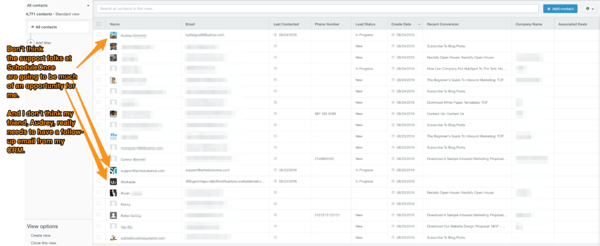
- Create Your Own View—Creating a view is really simple, and now that I’ve done it a few times, I really like the flexibility it gives me to look for new opportunities within my existing contacts. Just “Add Filter” and then look for the field you want to filter on. Choose your criteria, and you’re off to the races. Be sure to save your view if you’ve put any effort into it.
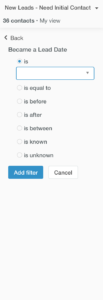
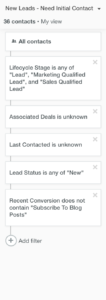
- Customize Your Views—Every view can have different columns of data depending on what you need to see to take the next step in the sales process. It’s easy to add or remove columns. Plus, for most columns you can filter by clicking the header, making it really easy to see what you want to see.
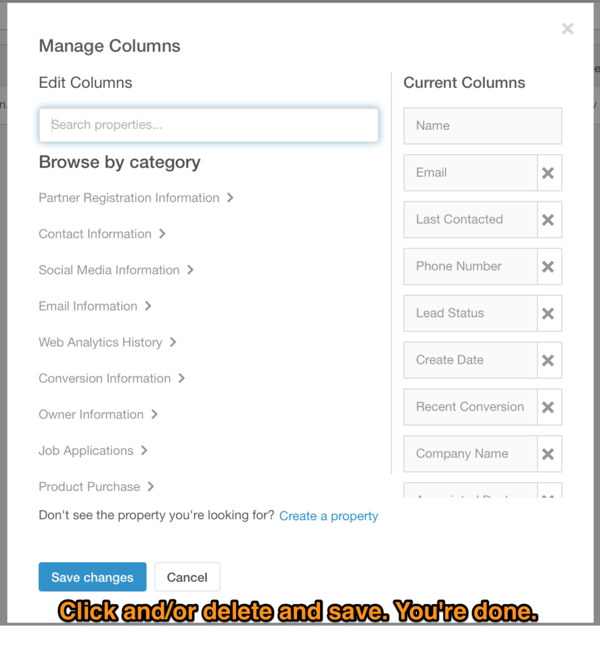
- Manage Your Contacts In Views—One feature I really like is that you can select multiple contacts from a view or list (if you want, you can select all contacts from multiple pages) and then do a Bulk Edit where you update any field for all selected contacts. This is a huge data management win for me. I just have to be careful not to accidentally overwrite something.


- Export Your View (But Not To HubSpot Marketing)—Maybe I’m missing something, but there doesn’t seem to be a way to take leads in one view and stick them in a list for the marketing side to use.
Single Contact View
- Single Contact Record—I like the fact that the properties that display first are completely configurable. That’s pretty standard for good CRMs, so it’s nice to see that here.

Action Panel
- New Note—Creating a new note is easy and gives you basic formatting, which is nice. Most of the time, I’m still creating my notes in Evernote because I’m super used to it, and then I paste them in. The editor seems to do a good job of keeping the formatting from Evernote, so that’s a big thumbs-up!
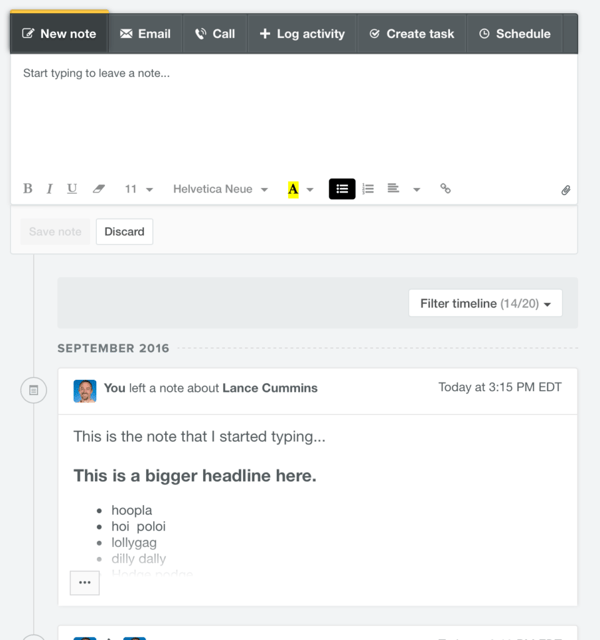
- Email—When you visit the email panel, at first it may be a little underwhelming, but the UX team did a great job of hiding some powerful functions where you can still access them.
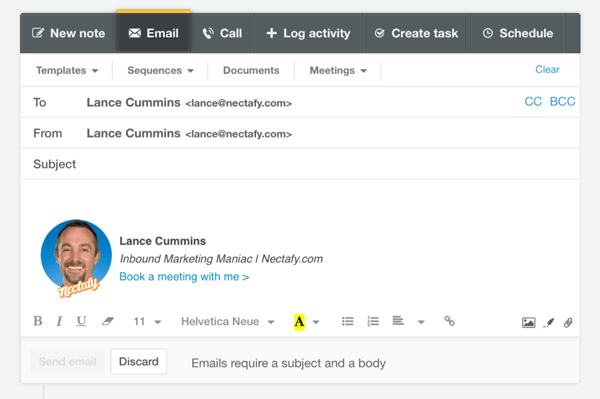
- Default Formatting—I’m not a huge fan of the default formatting, and unless I’m just a dunce, I can’t seem to figure out where to specify my preferred default formatting. When I drop a template in here, it seems to overwrite my settings. Not my favorite thing, but not a deal-killer either.
- Signature—You have the ability to build out a signature block for use in each of your emails. I highly recommend making it look like the signature you normally use so there’s consistency across your communication.
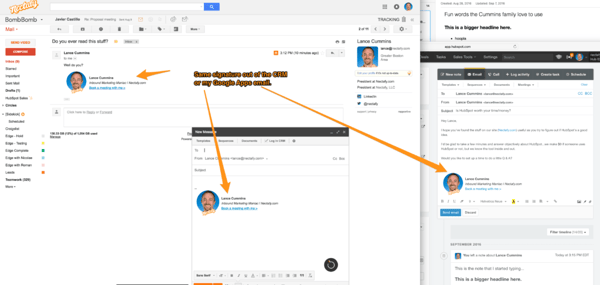
- Templates (Sales Free, limited to five)—One of the features that I love about the CRM is having templates available to drop in and easily customize for each email I send. I’m not a huge fan of templates—usually even the best ones sound kind of forced—but this lets me tweak and add a personal touch that really makes a difference. (I’ll show you more about templates when we review that particular page in HubSpot CRM.) Another great thing: They’re free! Up to five templates! Wait. What? This is a classic “gotcha.” I was so excited working with these templates when I started and then almost immediately hit the “Pay Wall.” Unfortunately, you’re not going to see that reality clearly laid out on the CRM page or the HubSpot sales page. This is probably one of my biggest gripes—how HubSpot has positioned this CRM as free.
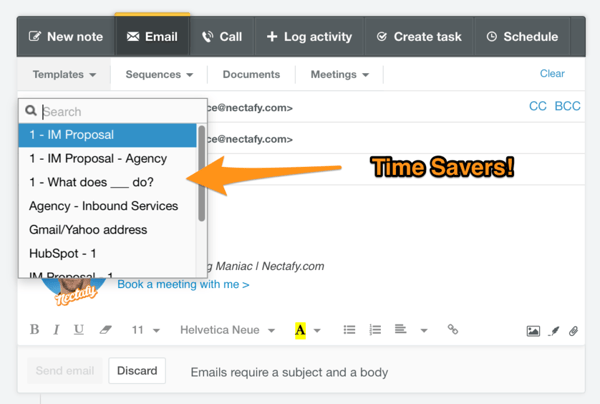
- Sequences (Sales Pro version only)—Sequences are basically templates you can set up to trigger automatically for a lead. This is ah-mazing! But with this power comes the ability to do really stupid things. Fortunately, HubSpot provides a nice way to edit all of the auto-emails that will go out so you can make sure your prospect feels loved and not bombarded. If a prospect replies, the auto-sequence is stopped to let you carry on the conversation as you see fit.
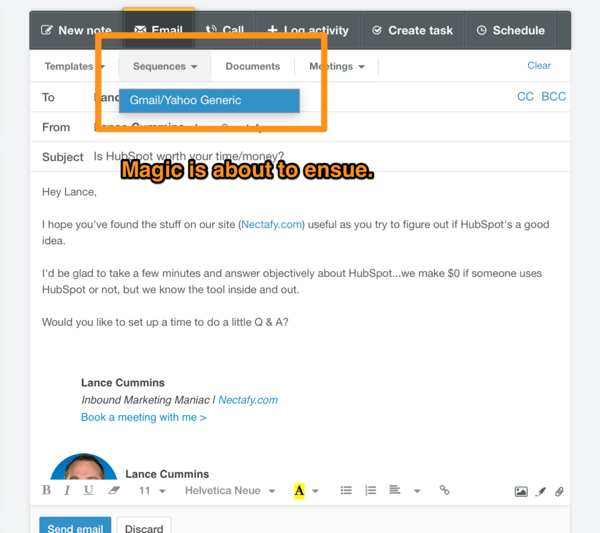
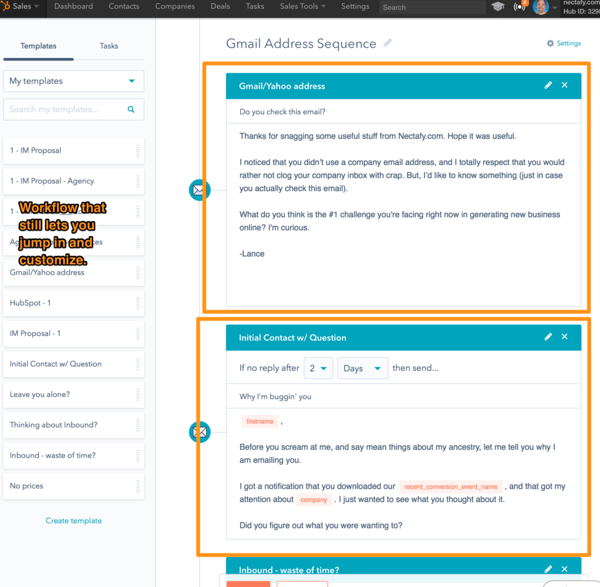
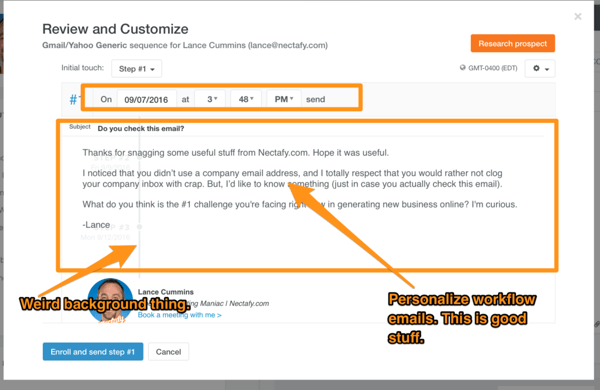
- Documents (limited in Sales Free version)—This section of the CRM is relatively new to me because we use our online resources as sales material. (We actually build out a landing page with sales resources for our prospects.) But if you rely on sending sales sheets or slide decks to prospects, you can include those documents easily in your communication and track whether the user clicks the links or not. That’s pretty nifty.
- Meetings (Sales Pro version only)—HubSpot CRM is really very close to some powerful functionality with its Meetings tab. Again, it stinks that you can’t do this with the free version, and HubSpot doesn’t make it clear that you can’t until you’re already in the game. But I digress...HubSpot CRM makes it simple to connect your calendar to the meetings app and then easily insert a meeting time right in your email to a prospect. In effect, it’s a super-simple way for a prospect to agree to meet with you. HubSpot CRM looks at your calendar and blocks out any times that you already have scheduled and then offers available times that you’ve preset.
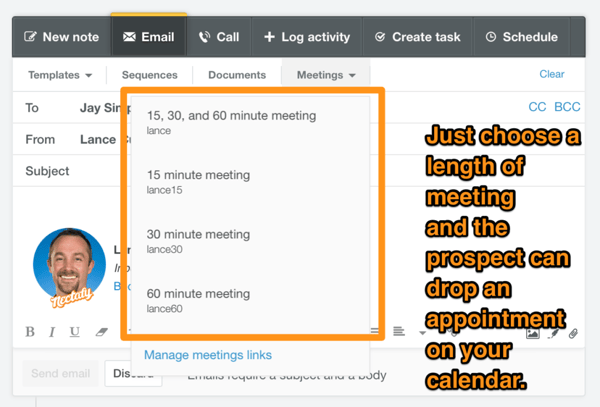
I have to confess that I don’t use this functionality because there is one important step missing from the app to make it worthwhile for me. I currently use ScheduleOnce, which is not super-attractive, but it requires the user to identify two possible times so I can then choose the best time for me. I work very hard to schedule my own time efficiently, so I try to batch meetings and so forth. If HubSpot CRM added that one option, I think this would be a home run.
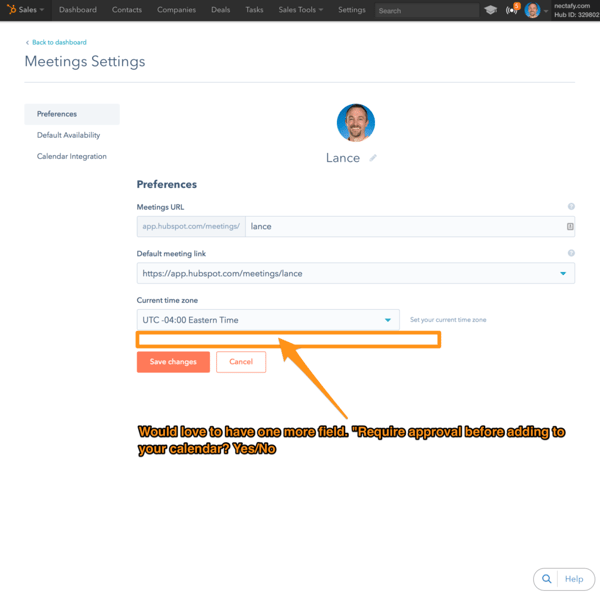
I also just recently noticed that HubSpot added a group scheduling function. That could be really powerful. Of course, if that requires all team members to be on the Sales Pro version at $50 each, that will be price-prohibitive for my company. I’ll show you the math a little further down in this article. They’ve also added round-robin scheduling, which could be useful for larger sales teams. Props to the HubSpot CRM team for this kind of big thinking.
One last thought: When I use HubSpot CRM Meetings, I don’t receive notifications when people schedule appointments with me. I just stumble on the meetings on my calendar. It may be a weird setting that I haven’t fixed, but that feels pretty weird to me.
- Calls—At this point I don’t automatically call leads, but HubSpot CRM does make it possible to add your company number and dial through the interface. If you’re relying on an outbound sales methodology this could be a really interesting feature.
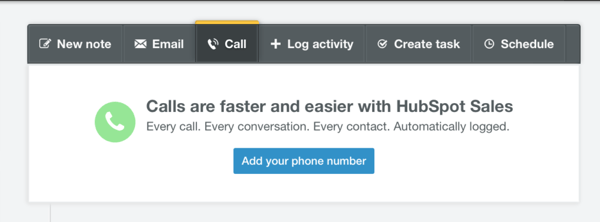
- Log Activity—It’s important to be able to track all interactions, so sometimes you’ll need to enter that data here. Simple feature, but it’s well-executed.
- Create Task—If you need to remind yourself to take the next step with a contact (or with a deal), you can add the task here. It will add that task to the Tasks window, then send you an email notification when it’s time to take action. I think there is plenty of room for development with this particular feature, but it’s simple and out-of-the-way for now. I probably just need to develop a better process for accessing the Tasks panel so that I can make better use of it.
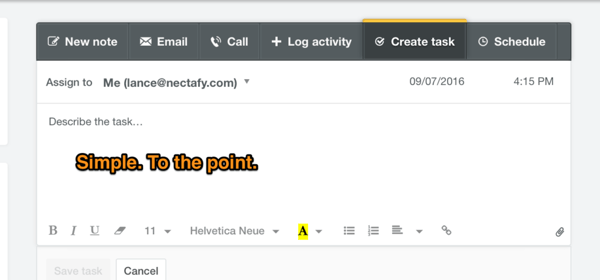
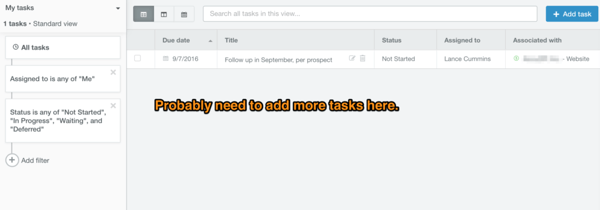
- Schedule—In an effort to keep you working efficiently right from the CRM, you can add meetings to your Google Calendar right here. Nice touch.
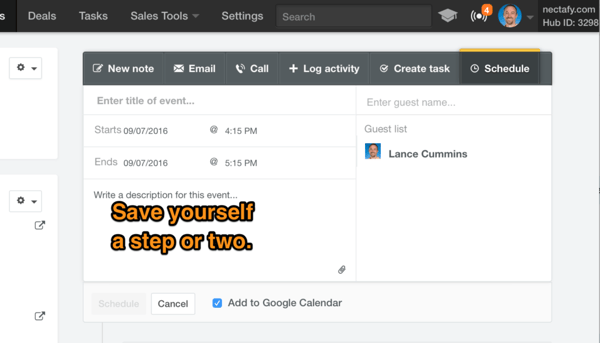
Deals Panel
Within the contact page, you can see every contact’s related deals and the status of each. Click on the deal to work with it. Nothing too complicated here. I like having easy access.
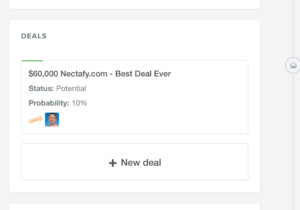
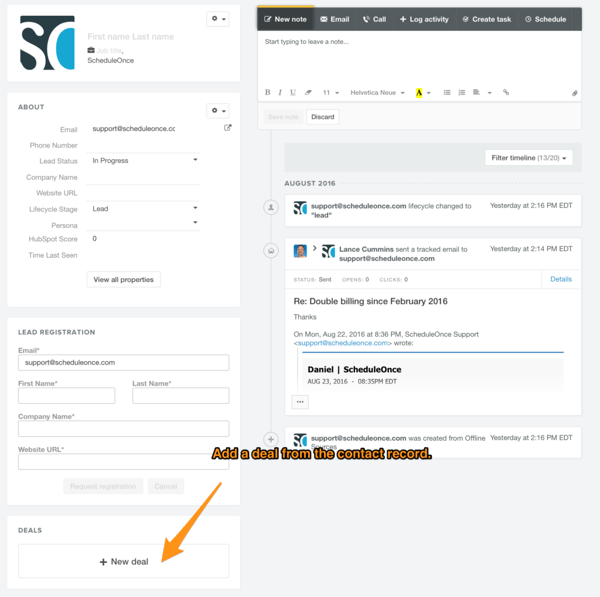
Company Panel
HubSpot finds a bunch of info about the user’s company and tries to populate that info here. One word of caution—the annual revenue field is a wild guess, so don’t get too excited about your newest prospects being loaded.
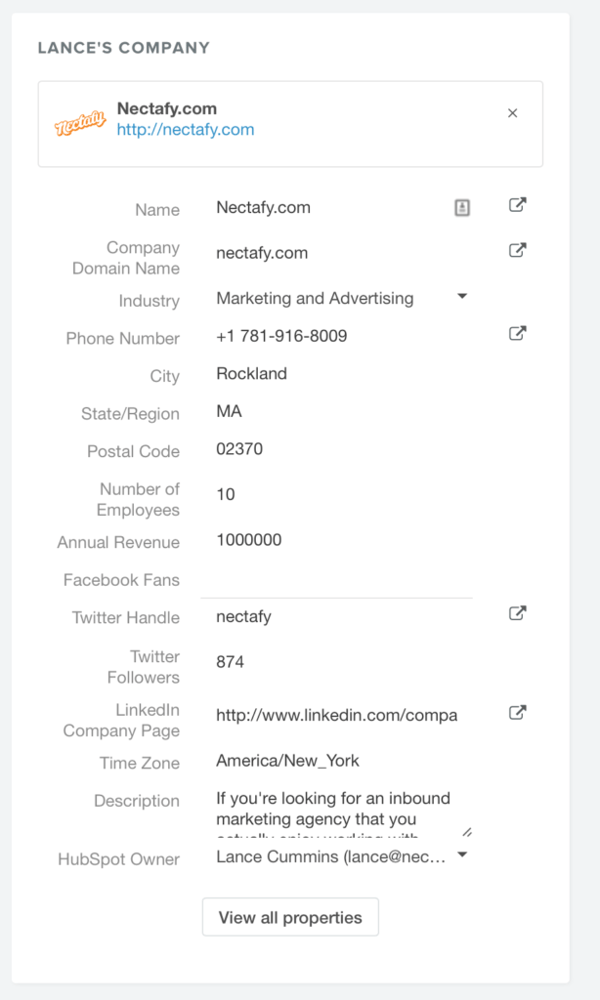
List Memberships Panel
If you’re working with the HubSpot Marketing side of things you may want to see what lists your contact is a part of to know what kind of interaction they’ll get with your company.
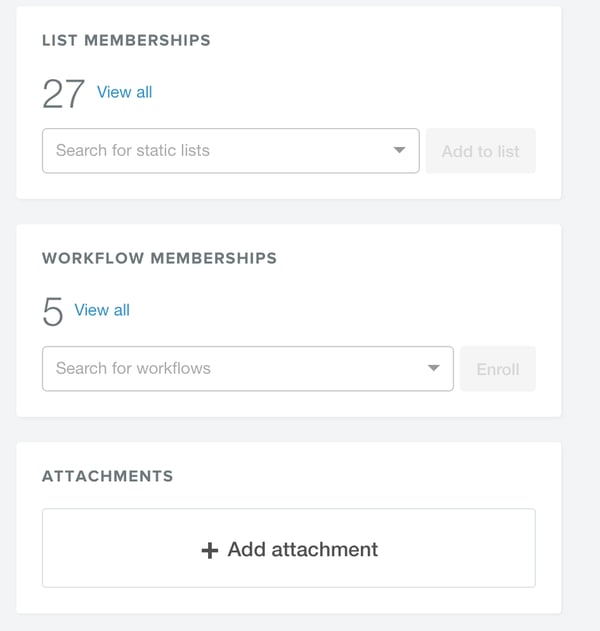
Workflow Memberships Panel
Workflows are a part of the marketing side of HubSpot, so this is a pretty useful place to see what kind of emails/actions will be taken on the marketing side. I would highly recommend creating a field that lets the marketing side know that you’re working with a prospect on the sales side so they don’t blow up your prospect’s inbox with other messages while you’re carrying on a conversation.
Attachments Panel
I have never used this feature but you can see at a glance which documents you’ve sent to your prospects.
Timeline
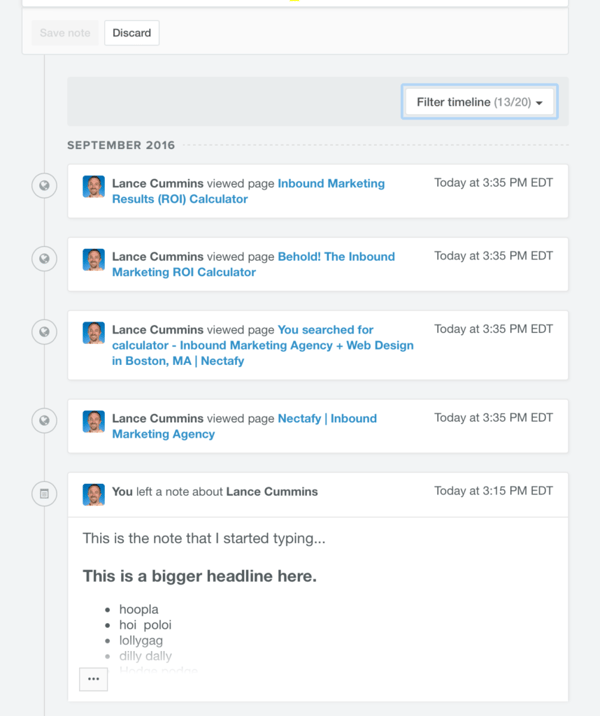
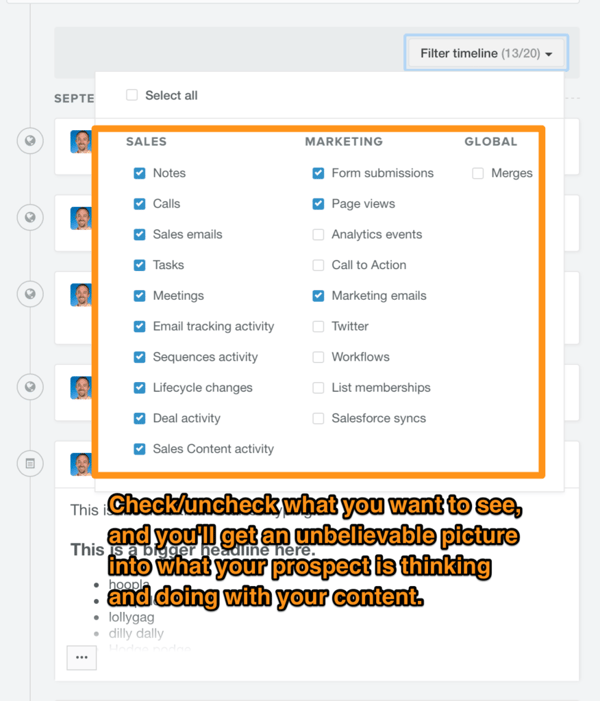
This is where much of the magic happens in HubSpot CRM for seeing how your prospect is engaging with your company and your communication online. On the timeline, you can choose what kind of activity you’d like to see and dig down pretty quickly. This part of the CRM is really, really strong. I do wish that, when you have an email communication on the timeline, you had the ability to “reply” to the user and it would populate our email panel and let us remind the user that we’ve sent a previous email. That’s a pretty handy technique for getting someone to respond in some way.
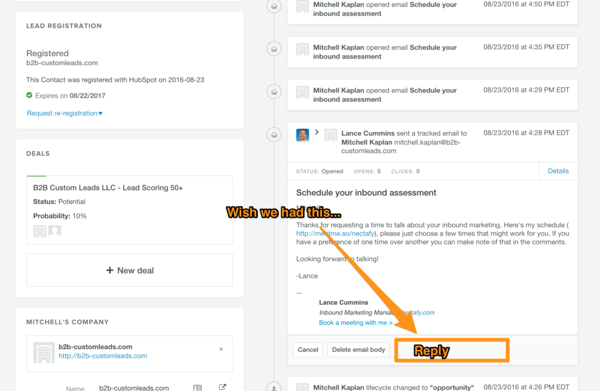
Companies
Honestly, I don’t spend much time here, but if I had complex conversations with multiple people from a single company, I can see how this section would be helpful. Basically, you have all the same functionality you have in Contacts for Companies.
Deals
Love this section. With the columns and draggable cards it closely resembles what I loved so much about Pipedrive (with the exception of a visual reminder about which deals need some action), but I’ve already covered that in the three-month review above. I did learn, thanks to one helpful commenter (see below), that I can create Views here and hide all of those annoying “Closed Lost” deals that mock my every move. So now I don’t have to stare at them. It’s easy to add and edit Deal Stages to match my sales process, and you can have multiple pipelines. But I’m not quite that complicated.
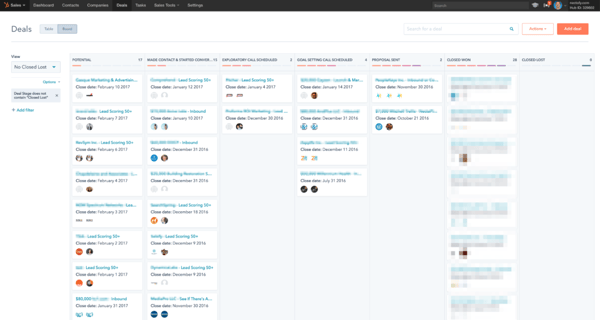
Tasks
The interface here is very helpful, and allowing filters makes a ton of sense once you start really using the functionality. I’m going to spend some time using this piece before I try to give a helpful critique on it.
Sales Tools
Notifications
This feature is helpful if you don’t want to get any other work done… ever. Every time someone interacts with one of your emails or visits the site or sneezes, you’ll see a notification in the top right corner of your screen. Of course, I exaggerate, but I’m sure it’s extremely helpful if you’re trying to figure out what’s currently happening with your efforts. The good news is that you can turn off the notifications and just view the activity stream when you’re curious about what’s going down with all the sales work you’ve been doing.
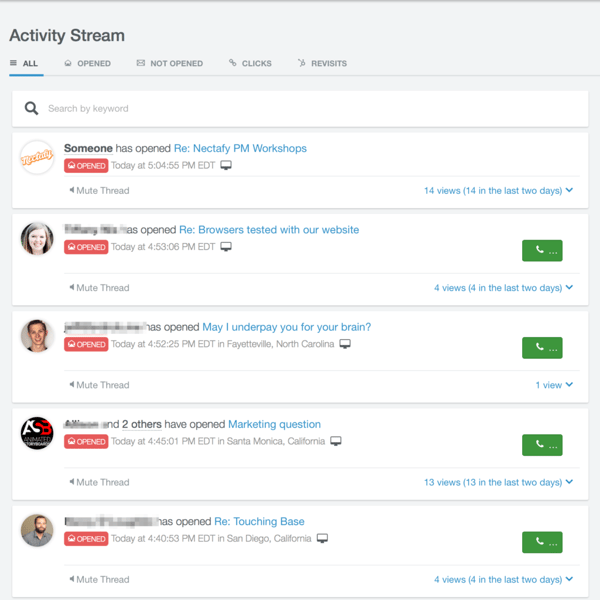
Templates
We’ve already talked about how templates are used. This section gives you a way to see some analytics on these templates and do some editing and housekeeping. It’s good for the task.
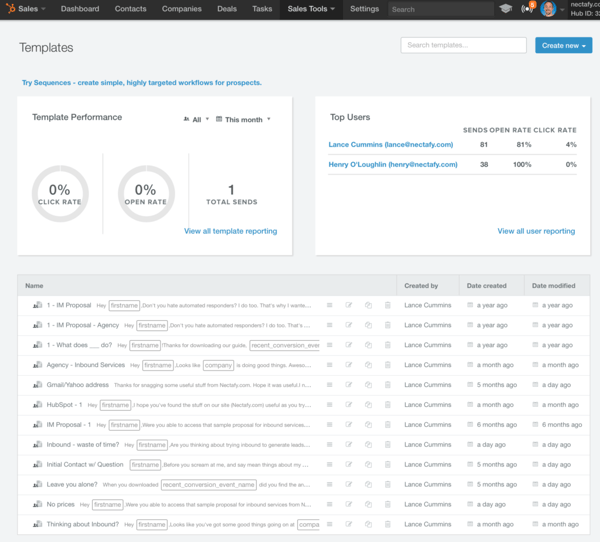
Sequences
Just like templates, this is the place to assign your sequences and do some housekeeping on them. I’ve already covered what I think about these sequences, so I won’t drone on.
Documents
Again, I talked through these in the contact record. I think it would work great if you use a lot of documents in your sales process. I don’t, so this area is gathering a bit of digital dust.
Prospects
HubSpot gathers the names of companies whose employees have visited your site based on their IP address. I think this section is interesting but, for the life of me, I can’t figure out what to do with that information. For the most part, companies that have their own blocks of IP addresses are huge, so I don’t think I could call their 800 number and say, “Um, yeah, somebody from your company was on my site. Could I talk to them?” But again, I don’t rely heavily on dialing out for sales. Maybe this is super helpful for some.
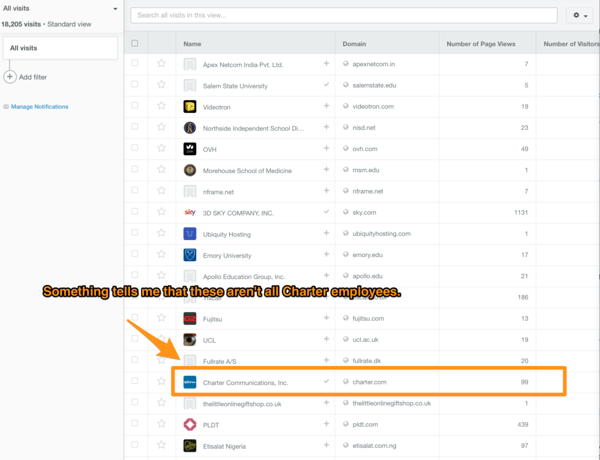
Meetings (Sales Pro Version Only)
This is the main panel for managing the settings and types of meetings that you can book. I’ve talked about the meetings function already, and I think HubSpot is really on the right track here. I do wish I could choose to have to manually approve meeting requests.
Call Queue
Apart from the delight of occasionally getting to say the word “queue,” I don’t use this section at all. It appears pretty simple to use, and if you’ve got a full-time phone sales team member, I imagine this would work great for them.
Integrations
There is a fantastic Chrome extension that enables you to use most of the HubSpot CRM email features in your Google Apps email account. This is one of my favorite things. There is also a way to integrate with Outlook, but honestly, I can’t stand Outlook, and I don’t think you should either. (I kid on the second part.)
Mobile App
Rather than compound an already-too-long review of HubSpot CRM with a review of its mobile app, I’ll commit to writing a separate review so I can dedicate some time to using it more. Honestly, as part of my personal commitment to keeping my work limited to “work time,” I rarely use my phone for more than making calls, occasional email checks, sometimes peeking at NFL.com to see how the Patriots are doing, and briefly scanning meaningless news items that tend to both paralyze and uninspire me. (I’ll rant about this last point sometime when I convince myself that someone actually cares to hear my opinion.) Since I don’t travel much during work, I have relatively little need for the mobile app. I will say that it looks very well-designed and well-planned. I wish I could be more helpful, but I can’t.
What I Wish It Could Do
- I’d love to be able to send custom emails to small batches of contacts quickly, without flipping over to the marketing side. If you don’t use HubSpot for its marketing capabilities this won’t matter to you, but if you do, it’s a bit puzzling that you can’t make this easy transition.
- I would also like to have the option not to add contacts from Gmail if they don’t already exist in my HubSpot marketing side. It doesn’t make sense to add a contact just because I’ve emailed them, but that may just be a personal workflow issue. Yes, HubSpot provides a checkbox that you can uncheck if you don’t want to add someone, but I type and click “send” so quickly that I hardly ever think to uncheck it. The default checked state for “Log in CRM” is good, but I end up with a bunch of “leads that aren’t leads” in my sales tool, that I then have to go clean out from the CRM. This may not be an issue if you’re using just the CRM, but the minute you sign up for the marketing package, you’ll pay for people you aren’t actually trying to sell.
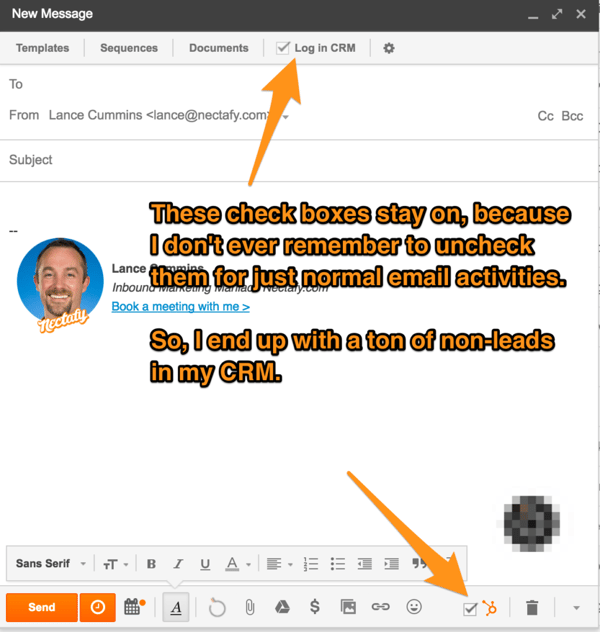
- While the CRM captures emails I send to prospects, it doesn’t append their replies. This leaves me a little confused when I’m looking at a prospect’s history and wastes a bit of time as I dig into my email to see if they ever replied.
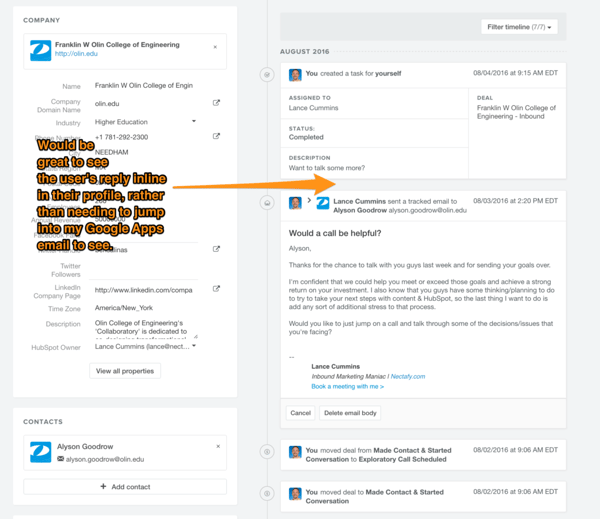
- I want the CRM to provide a setting to allow manual approval of meeting scheduling (see above for more detail) rather than just automatically appending it to my calendar.
Pricing
Probably my biggest complaint about HubSpot CRM is the way HubSpot talks about pricing and tools. Maybe they’re genius in the way they’ve split up two key functions of a CRM—organizing/tracking leads or customers and selling—but I think it’s super-confusing to figure out what you get and don’t get. I’m going to try to piece this together for you in a meaningful way.
First, HubSpot boldly asserts that the CRM is completely free. The website asserts, “HubSpot CRM has free tools for everyone on your team, and it’s 100% free — forever. .” Yep. Kind of. You can certainly “organize” and to a degree you can “track” the activity of a lead with this CRM without paying a dime. And I should pause and say how amazing that is. Kudos to HubSpot for providing a great tool that makes this kind of functionality available to the masses for free.
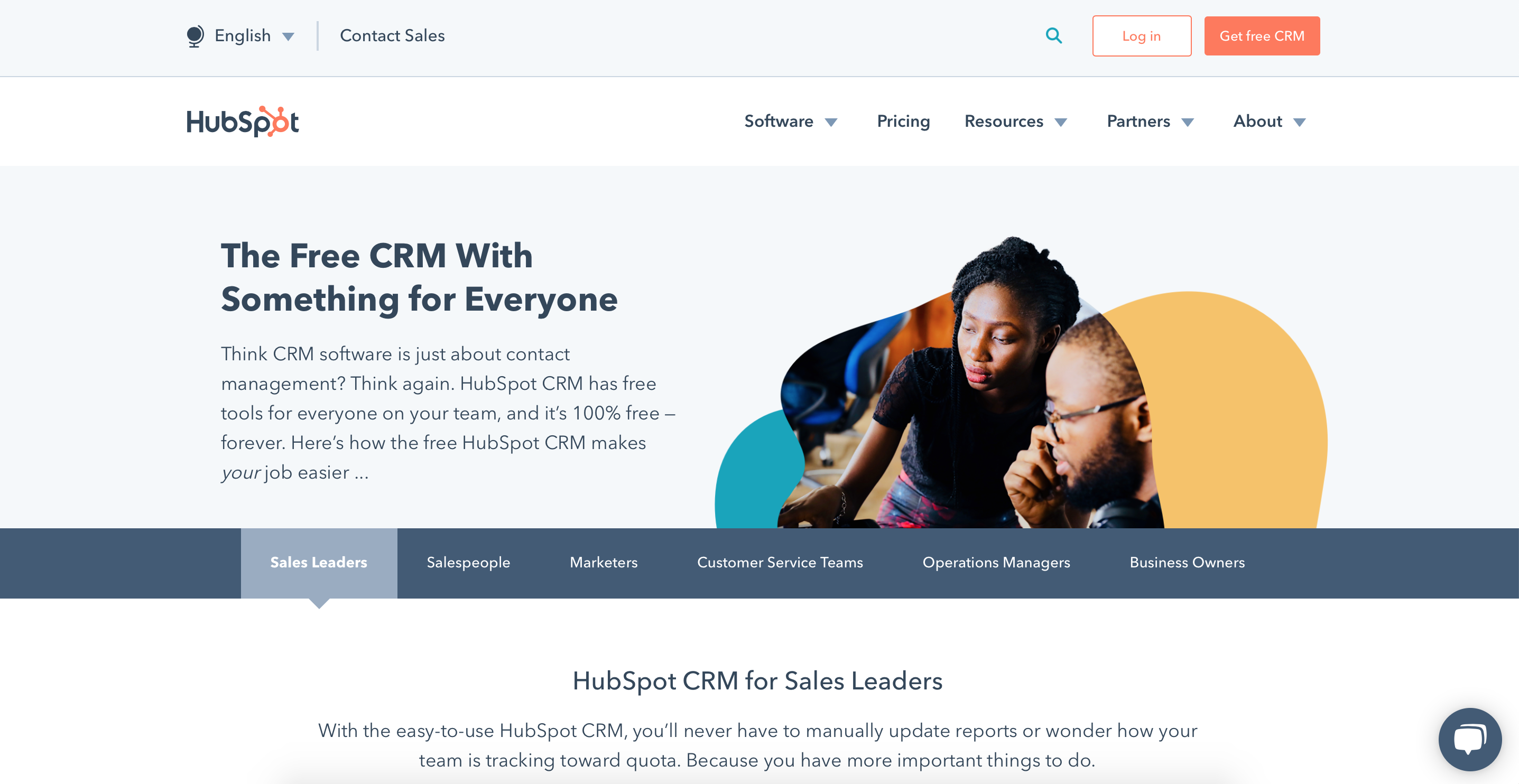
But before you rush out and add all of your sales team to HubSpot CRM because, “Hey, it’s free,” you should realize that if your team is going to take advantage of the sales tools—templates and sequences and so forth—you’re going to pay.
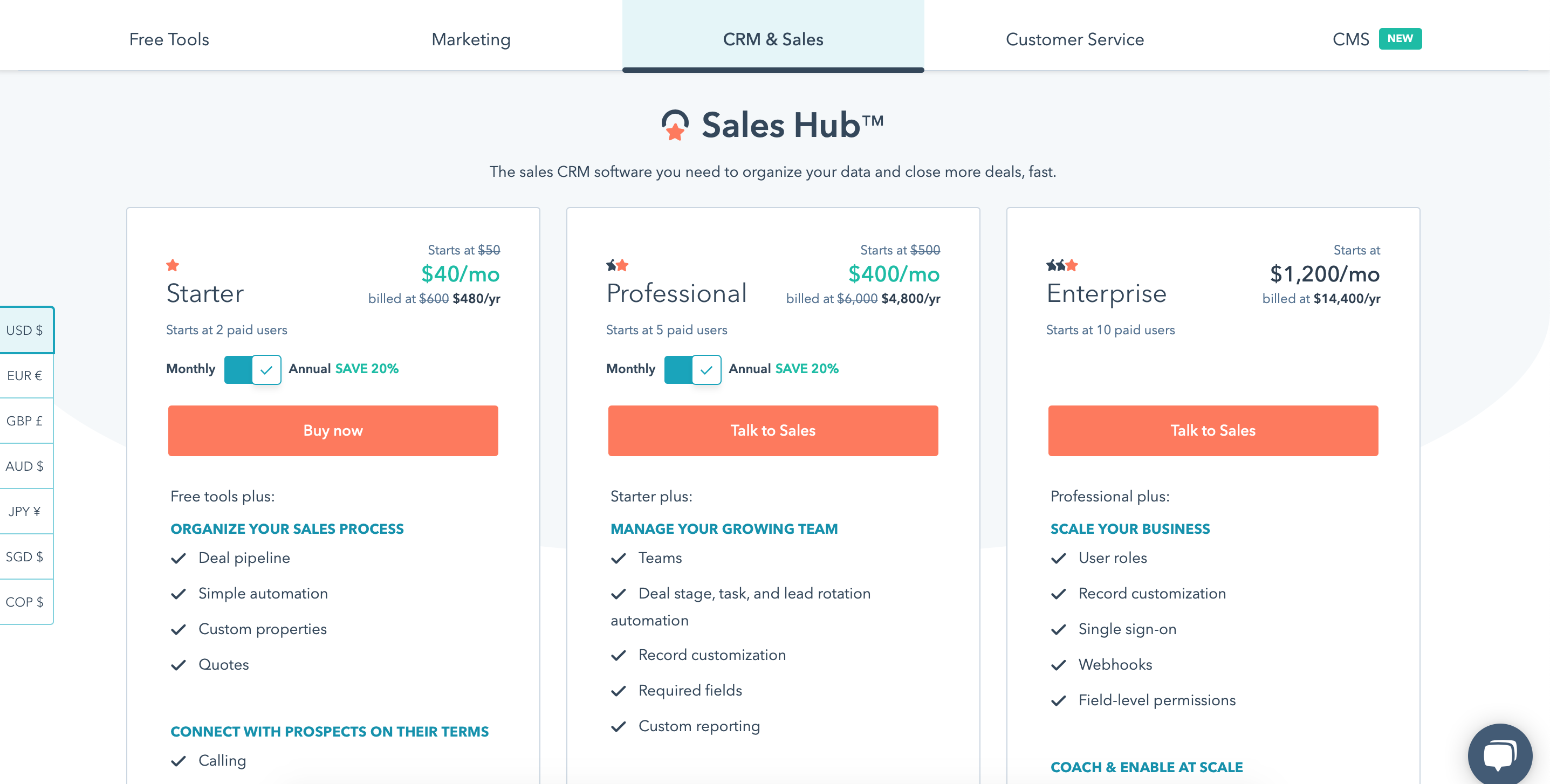
This is where my biggest gripe is with HubSpot’s pricing strategy. They say “Free” everywhere and then bury some hard-hitting truths in the website’s FAQ section. So, I’ll spell it out.
If you have a sales team of five people, for instance, the cost looks like this:
Cost For HubSpot CRM For A Sales Team Of 5
- $400 per month for the Professional package
- $200 per month for the Reporting Add-on
- Total: $600 per month ($120 per user)
If you’re looking at CRMs, chances are you’ve thought about Salesforce... because it’s the 800-pound gorilla in the CRM space. From looking at its pricing page, a comparable plan to what you would get with HubSpot CRM is the Lightning Professional plan, which lists at $75 per user per month. I was surprised to see that HubSpot CRM + Sales + Reporting is more expensive.
However, after looking at Salesforce’s design, dashboards, reports, and so forth, I think you may be paying another kind of price for all that ugliness. Oh boy, is that a disaster. It’s probably worth $15 per month to keep your sales team sane and happy. HubSpot CRM crushes Salesforce on design and user experience.
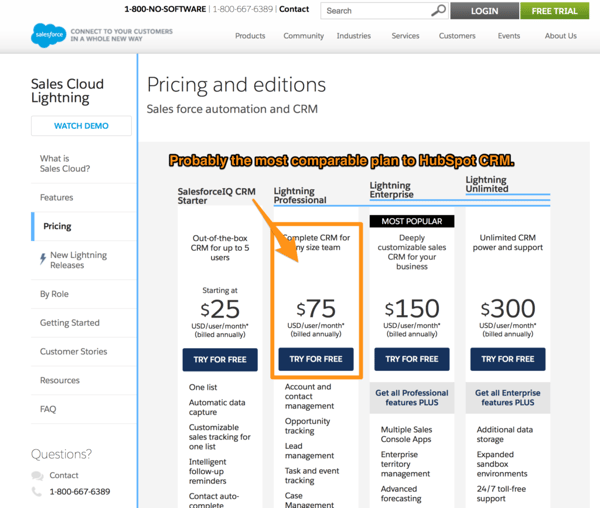
My Recommendation
My goal in this entire review is to help you feel comfortable jumping into HubSpot CRM with full knowledge of its challenges. I’ve been using the CRM for more than a year now, and, while I wouldn’t call myself a power user, I am in the tool daily. I continue to be impressed with HubSpot’s dedication to improving the CRM—it’s obvious to me that they’re gearing up for a toe-to-toe with other marketing/sales packages out there, like Pardot/Salesforce.
If you need a ridiculous amount of customization and special “business logic” tools, go with Salesforce. If you simply need to sell better and feel confident in your tool set, go with HubSpot CRM.
At the very least, do the free trial for HubSpot CRM and see for yourself.
Hey, what have you got to lose? It’s free.
Kinda.

